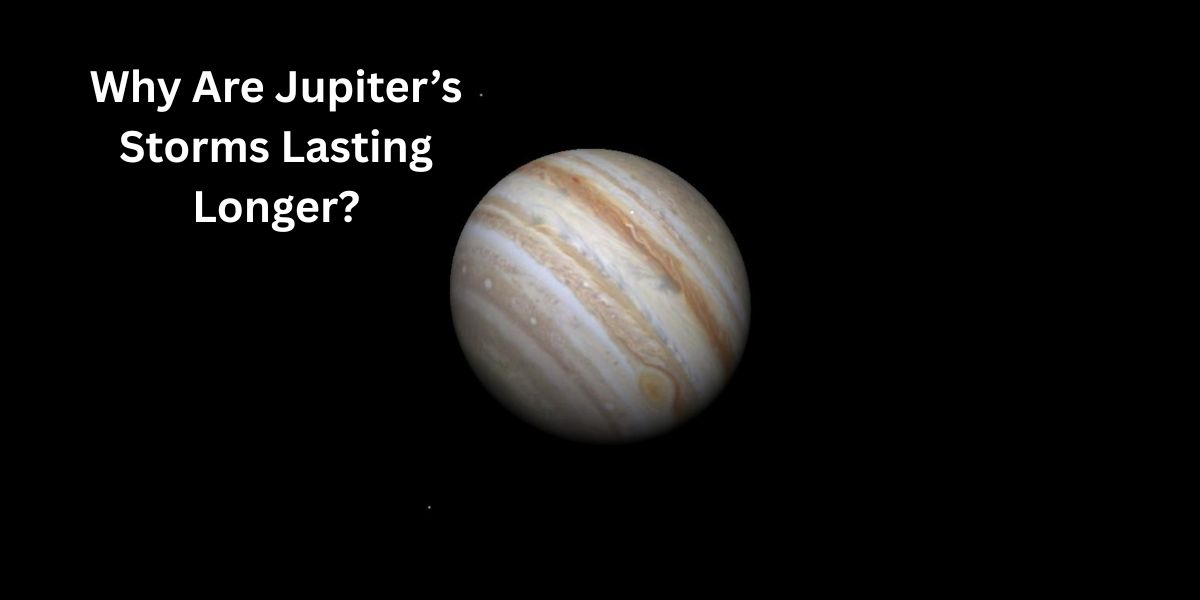Have you ever looked at pictures of Jupiter? The giant planet is covered in swirling storms, with the most famous one being the Great Red Spot—a storm so big it could fit three Earths inside it! But scientists have noticed something strange: Jupiter’s storms, especially the Great Red Spot, are lasting much longer than expected.
Why is this happening? Storms on Earth, like hurricanes, usually last for days or weeks before fading away. But Jupiter’s storms have been raging for hundreds of years! What makes them so different? Could Jupiter’s weather be changing? Let’s find out!
What Causes Storms on Jupiter?
Jupiter is a gas giant, meaning it has no solid ground—just thick layers of gas. Its storms are powered by heat rising from deep inside the planet. Unlike Earth, where storms get weaker when they hit land, Jupiter’s storms keep spinning because there’s nothing to stop them!
Here’s why Jupiter’s storms are so strong:
- Fast Winds: Jupiter’s winds can reach 300 miles per hour—much faster than Earth’s strongest hurricanes.
- No Land: With no mountains or oceans to slow them down, storms can last for centuries.
- Constant Energy: Jupiter gives off more heat than it gets from the Sun, feeding its storms.
Fun Fact: The Great Red Spot has been shrinking over the years, but it’s still the biggest storm in our solar system!
Why Are Jupiter’s Storms Lasting So Long?
Scientists believe Jupiter’s storms last longer because of three main reasons:
- Size and Spin: Jupiter is huge—it spins so fast (once every 10 hours) that its storms get trapped in swirling jet streams, keeping them alive.
- No Friction: On Earth, storms lose energy when they hit land. Jupiter has no land, so storms keep going.
- Deep Roots: Jupiter’s storms may stretch hundreds of miles deep, pulling energy from the planet’s hot interior.
Think of Jupiter like a giant pot of boiling soup. The heat keeps rising, creating bubbles (storms) that never pop!
Is the Great Red Spot Disappearing?
For over 150 years, scientists have watched the Great Red Spot slowly shrink. In the 1800s, it was three times wider than Earth—now it’s just a little bigger than our planet. But even as it gets smaller, it’s not fading away quickly.
Some experts think the storm is changing shape rather than dying. It might be getting taller while becoming narrower. Others believe it’s merging with smaller storms, which could keep it alive for many more years.
Will the Great Red Spot vanish one day? Maybe—but not anytime soon!
How Do Jupiter’s Storms Compare to Earth’s Storms?
Earth’s storms are tiny compared to Jupiter’s! Here’s how they’re different:
| Feature | Earth’s Storms | Jupiter’s Storms |
|---|---|---|
| Duration | Days to weeks | Hundreds of years |
| Size | Up to 1,000 miles wide | Bigger than Earth |
| Speed | Up to 200 mph | Over 300 mph |
| Energy Source | Sun & ocean heat | Jupiter’s internal heat |
Jupiter’s storms are like supercharged versions of Earth’s hurricanes—bigger, faster, and much longer-lasting!
Could Jupiter’s Storms Ever Stop?
Probably not anytime soon! As long as Jupiter has:
- Internal heat (from its formation and gravity).
- Fast spinning motion (which keeps winds moving).
- No solid surface (so nothing stops the storms).
Its storms will keep raging. However, if Jupiter cools down over billions of years, its storms might finally slow down. But for now, Jupiter remains the storm king of our solar system!
Conclusion
Jupiter’s storms last longer because the planet is big, fast, and full of energy. Unlike Earth, where storms fade quickly, Jupiter’s weather never stops. The Great Red Spot might be shrinking, but it’s still a powerful storm after hundreds of years.
📌 Frequently Asked Questions
How old is Jupiter’s Great Red Spot?
The Great Red Spot has been observed since the 1600s, meaning it’s at least 400 years old—maybe even older!
Can Jupiter’s storms be seen from Earth?
Yes! With a good telescope, you can see Jupiter’s storms, including the Great Red Spot.
Why is the Great Red Spot red?
Scientists aren’t 100% sure, but they think chemicals like ammonia and sulfur turn red when exposed to sunlight.
Does Jupiter have lightning?
Yes! Jupiter has huge lightning bolts, much stronger than Earth’s.
Could a spaceship fly through Jupiter’s storms?
No—the winds are too strong, and the pressure would crush any spacecraft.
Is Jupiter’s Great Red Spot the only storm?
No! Jupiter has many smaller storms, some white and some red.
Will Jupiter’s storms ever reach Earth?
No—Jupiter is too far away, and storms can’t travel between planets.How do scientists study Jupiter’s storms?
How do scientists study Jupiter’s storms?
They use telescopes and space probes like NASA’s Juno mission.
Could life survive in Jupiter’s storms?
Probably not—the winds and pressure are too extreme for life as we know it.
Has Jupiter always had storms?
Most likely! Jupiter has been stormy since it formed 4.5 billion years ago.
